
The men's pommel horse was a gymnastics event contested as part of the Gymnastics at the 1964 Summer Olympics programme at the Tokyo Metropolitan Gymnasium. The event was held on 18, 20, and 22 October. There were 128 competitors from 29 nations, with nations in the team competition having up to 6 gymnasts and other nations entering up to 3 gymnasts. The event was won by Miroslav Cerar of Yugoslavia, the nation's first medal in the pommel horse. Silver went to Shuji Tsurumi of Japan, the third man to win multiple medals in the event. Yury Tsapenko of the Soviet Union took bronze, breaking a three-Games gold medal streak for the Soviets.
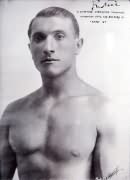
The men's artistic individual all-around event was part of the gymnastics programme at the 1932 Summer Olympics. It was the eighth appearance of the event, which was established in 1900. The competition was held from Monday, August 8, 1932, to Wednesday, August 10, 1932. Twenty-four gymnasts from five nations competed. Each nation could enter a team of 5 gymnasts; Hungary sent only 4. The event was won by Romeo Neri of Italy, the nation's first victory in the event since 1920 and fourth overall. István Pelle of Hungary took silver and Heikki Savolainen of Finland earned bronze; it was the first medal in the event for each nation.

The men's pommel horse competition was one of eight events for male competitors in artistic gymnastics at the 1996 Summer Olympics in Atlanta. The qualification and final rounds took place on July 20, 22 and 28th at the Georgia Dome. There were 102 competitors from 31 nations, with nations in the team event having up to 7 gymnasts and other nations having up to 3 gymnasts. The event was won by Li Donghua of Switzerland, the nation's first victory in the men's pommel horse since 1928. It was the first time since 1980 that the pommel horse did not have a tie for first place. Marius Urzică earned Romania's first pommel horse medal with his silver, while Alexei Nemov earned Russia's first as a nation separate from the Soviet Union with his bronze.
The men's pommel horse competition was one of eight events for male competitors in artistic gymnastics at the 1992 Summer Olympics in Barcelona. The qualification and final rounds took place on 27 July, 29 July and 2 August at the Palau d'Esports de Barcelona. There were 93 competitors from 25 nations, with nations in the team event having 6 gymnasts while other nations could have up to 3 gymnasts. For the third consecutive Games, the pommel horse ended in a tie for the gold medal. Belarusian Vitaly Scherbo and North Korean Pae Gil-su shared the top place. It was North Korea's first medal in the event. Bronze went to Andreas Wecker of Germany.

The men's pommel horse competition was one of eight events for male competitors in artistic gymnastics at the 1988 Summer Olympics in Seoul. The qualification and final rounds took place on September 18, 20 and 24th at the Olympic Gymnastics Hall. There were 89 competitors from 23 nations, with nations competing in the team event having 6 gymnasts and other nations having up to 3 gymnasts. For the second time, the event ended in a three-way tie for first place. Dmitry Bilozerchev of the Soviet Union, Zsolt Borkai of Hungary, and Lubomir Geraskov of Bulgaria each received a gold medal. It was Bulgaria's first medal in the pommel horse. Hungary had its third gold medal in four Games, with Zoltán Magyar winning in 1976 and 1980 before the nation was part of the Soviet-led boycott in 1984. The Soviets had had an eight-Games medal streak in the event snapped by that boycott; Bilozerchev's medal put the nation back on the podium after that one-Games absence.

These are the results of the men's pommel horse competition, one of eight events for male competitors in artistic gymnastics at the 1972 Summer Olympics in Munich. The qualification and final rounds took place on August 27, 29 and September 1 at the Sports Hall. There were 111 competitors from 26 nations ; nations entering the team event had 6 gymnasts while other nations could have up to 3 gymnasts. The event was won by Viktor Klimenko of the Soviet Union, the nation's fourth victory in the men's pommel horse. Sawao Kato (silver) and Eizo Kenmotsu (bronze) returned Japan to the pommel horse podium after a one-Games absence.

The men's pommel horse competition was one of eight events for male competitors in artistic gymnastics at the 1976 Summer Olympics in Montreal. The qualification and final rounds took place on July 18, 20, and 23rd at the Montreal Forum. There were 90 competitors from 20 nations, with nations competing in the team event having 6 gymnasts while other nations could have up to 3 gymnasts. The event was won by Zoltán Magyar of Hungary, the nation's first victory in the pommel horse since 1932. Eizo Kenmotsu of Japan was the fifth man to win multiple medals in the event, adding a silver to his 1972 bronze. Nikolai Andrianov of the Soviet Union and Michael Nikolay of East Germany tied for third, each receiving bronze medals; this was East Germany's first medal in the event while the Soviet Union stretched its podium streak to seven Games.

The men's pommel horse competition was one of eight events for male competitors in artistic gymnastics at the 1980 Summer Olympics in Moscow. The qualification and final rounds took place on July 20, 22 and 25 at the Luzhniki Palace of Sports. There were 65 competitors from 14 nations, with nations competing in the team event having 6 gymnasts while other nations could have to up to 3 gymnasts. The event was won by Zoltán Magyar of Hungary, the third man to successfully defend an Olympic title in the pommel horse. Silver went to Alexander Dityatin, extending the Soviet Union's podium streak in the event to eight Games. Michael Nikolay of East Germany took bronze for the second consecutive Games. Magyar and Nikolay were the sixth and seventh men to earn multiple pommel horse medals.

The men's pommel horse competition was one of eight events for male competitors in artistic gymnastics at the 1984 Summer Olympics in Los Angeles. The qualification and final rounds took place on July 29, 31 and August 4 at UCLA’s Pauley Pavilion. There were 71 competitors from 19 nations, with nations competing in the team event having 6 gymnasts while other nations could have to up to 3 gymnasts. The event was won in a tie between Li Ning of China, in the nation's debut in the Games, and Peter Vidmar, with the United States' first gold medal in the pommel horse since 1904 and first medal in the event since 1932. The bronze medal went to another American, Tim Daggett. The Soviet Union's eight-Games podium streak in the event ended with no Soviets competing due to the boycott.
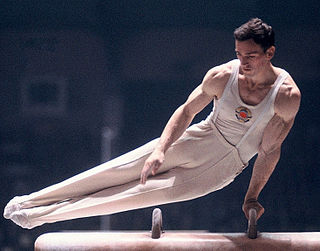
The men's pommel horse competition was one of eight events for male competitors in artistic gymnastics at the 1968 Summer Olympics in Mexico City. The event was held from 22 to 26 October at the Auditorio Nacional. There were 115 competitors from 27 nations, with nations in the team competition having up to 6 gymnasts and other nations entering up to 3 gymnasts. The event was won by Miroslav Cerar of Yugoslavia, the second man to successfully defend an Olympic pommel horse title. Olli Laiho of Finland took silver, while Mikhail Voronin of the Soviet Union finished with bronze. Japan's three-Games podium streak in the event ended, while the Soviet streak stretched to five Games.
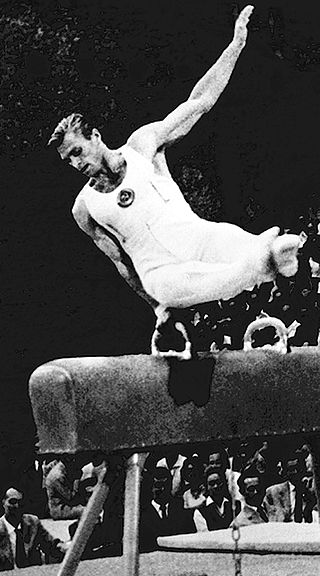
The men's pommel horse competition was one of eight events for male competitors in artistic gymnastics at the 1960 Summer Olympics in Rome. It was held on 5, 7, and 10 September at the Baths of Caracalla. There were 128 competitors from 28 nations, with nations in the team competition having up to 6 gymnasts and other nations entering up to 2 gymnasts. There was a tie for first place in the pommel horse. Boris Shakhlin of the Soviet Union and Eugen Ekman of Finland each received a gold medal. It was the third consecutive Games with a gold medal for the Soviets, as Shakhlin became the first man to successfully repeat as Olympic champion in the event. Ekman's medal was the only medal in men's artistic gymnastics in 1960 that did not go to the Soviet Union or Japan. Third place and the bronze medal went to Japan's Shuji Tsurumi.

The men's pommel horse competition was one of eight events for male competitors in artistic gymnastics at the 1956 Summer Olympics in Melbourne. It was held from 3 to 7 December at the Melbourne Festival Hall. There were 63 competitors from 18 nations, with nations in the team competition having up to 6 gymnasts and other nations entering up to 3 gymnasts. The event was won by Boris Shakhlin of the Soviet Union, the nation's second consecutive victory in the pommel horse. Takashi Ono earned Japan's first medal in the event with his silver. Soviet Viktor Chukarin became the first man to win multiple medals in the pommel horse, adding a bronze to his 1952 gold.
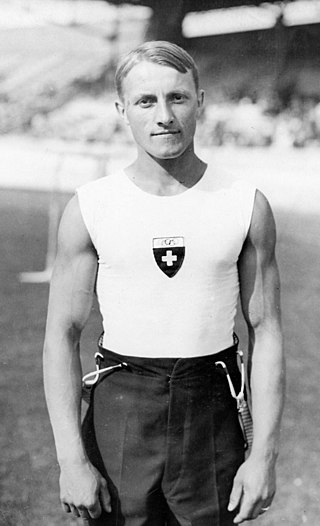
The men's artistic individual all-around event was part of the gymnastics programme at the 1928 Summer Olympics. It was one of seven gymnastics events for men and was the seventh Olympic men's all-around gymnastic championship. Scores from the individual apparatus events were added to give aggregate scores for the individual all-around; individual all-around scores were similarly summed for the team all-around event. There were 88 competitors from 11 nations. Each nation sent a team of 8 gymnasts. The event was won by Georges Miez of Switzerland, with his countryman Hermann Hänggi taking silver. They were the first medals in the event for Swiss gymnasts since 1904 and the first gold medal ever for a Swiss man in the individual all-around. Defending Olympic champion Leon Štukelj of Yugoslavia finished with the bronze this time, making him the third man to win multiple medals in the event.

The men's pommel horse competition at the 1936 Summer Olympics was held at the Waldbühne on 10 and 11 August. It was the sixth appearance of the event. There were 110 competitors from 14 nations, with each nation sending a team of up to 8 men. The event was won by Konrad Frey of Germany, the nation's first victory in the event and first medal since 1896. Switzerland earned the other two medals, with Eugen Mack getting silver and Albert Bachmann receiving bronze.
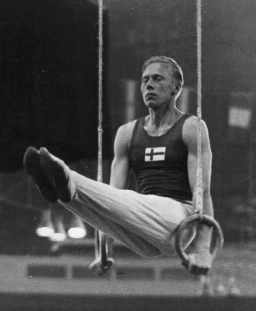
The men's artistic individual all-around competition at the 1948 Summer Olympics was held at Earls Court Exhibition Centre on 12 and 13 August. It was the tenth appearance of the event. There were 123 competitors from 16 nations, with each nation sending a team of up to 8 gymnasts. The event was won by Veikko Huhtanen of Finland, the nation's first victory in the men's all-around. Finland also earned bronze, with Paavo Aaltonen finishing third. For the second consecutive Games, Switzerland took silver—this time with Walter Lehmann as the nation's medalist.

The men's vault competition at the 1948 Summer Olympics was held at Earls Court Exhibition Centre on 12 and 13 August. It was the seventh appearance of the event. There were 120 competitors from 16 nations, with each nation sending a team of up to 8 gymnasts. The event was won by Paavo Aaltonen of Finland with fellow Finn Olavi Rove finishing second; the medals were the nation's first in the men's vault. There was a three-way tie for third place resulting in three bronze medals being awarded to János Mogyorósi-Klencs and Ferenc Pataki of Hungary and Leo Sotorník of Czechoslovakia.

The men's rings competition at the 1948 Summer Olympics was held at Earls Court Exhibition Centre on 12 and 13 August. It was the seventh appearance of the event. There were 121 competitors from 16 nations, with each nation sending a team of up to 8 gymnasts. The event was won by Karl Frei of Switzerland, with his countryman Michael Reusch earning silver; they were the nation's first medals in the event. Zdeněk Růžička of Czechoslovakia took bronze.

The men's horizontal bar competition at the 1948 Summer Olympics was held at Earls Court Exhibition Centre on 12 and 13 August. It was the seventh appearance of the event. There were 121 competitors from 16 nations, with each nation sending a team of up to 8 gymnasts. The event was won by Josef Stalder of Switzerland, with his countryman Walter Lehmann taking silver. It was the nation's second victory in the event, tying the United States for most all-time. Veikko Huhtanen of Finland earned bronze, giving Finland a three-Games podium streak in the event.

The men's parallel bars competition at the 1948 Summer Olympics was held at Earls Court Exhibition Centre on 12 and 13 August. It was the seventh appearance of the event. There were 122 competitors from 16 nations, with each nation sending a team of up to 8 gymnasts. The event was won by Michael Reusch of Switzerland, with his countrymen Christian Kipfer and Josef Stalder tying for bronze. Between the Swiss gymnasts was Veikko Huhtanen of Finland, taking silver. Reusch was the first man to win multiple medals in the event ; Stalder would become the second in 1952. It was Switzerland's second victory in the event, tying Germany for most gold medals.
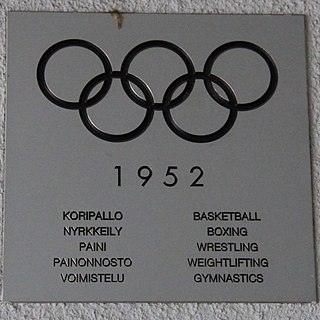
The men's pommel horse competition at the 1952 Summer Olympics was held at Töölö Sports Hall, Exhibition Hall I from 19 to 21 July. It was the eighth appearance of the event. There were 185 competitors from 29 nations, with each nation sending up to 8 gymnasts. The event was won by Viktor Chukarin as the Soviet Union swept the medals in its debut. It was the fourth medal sweep in the event, and last before apparatus finals with a two-gymnast-per-nation limit made further sweeps impossible. Yevgeny Korolkov and Hrant Shahinyan tied for silver.















